Management Accounting Assignment: Cost Analysis and Reporting
VerifiedAdded on 2019/12/03
|20
|5365
|224
Homework Assignment
AI Summary
This management accounting assignment provides a comprehensive analysis of costing and budgeting techniques. The solution begins with an introduction to different cost classifications (direct, indirect, function, nature, and behavior) and proceeds to compute the total and unit cost of a job using job costing. The assignment then demonstrates the application of absorption costing, including the allocation of overhead costs and the computation of cost per unit. A detailed analysis of cost data is performed using various techniques. The assignment further includes the preparation and analysis of routine cost reports, the use of performance indicators to identify potential business improvements, and recommendations for cost reduction and value enhancement. Budgeting processes are explained, with the selection of appropriate methods and preparation of production, material purchase, and cash budgets. Finally, variance analysis is conducted, identifying potential causes and recommending corrective actions, along with the preparation of a reconciliation operating statement and a management report.
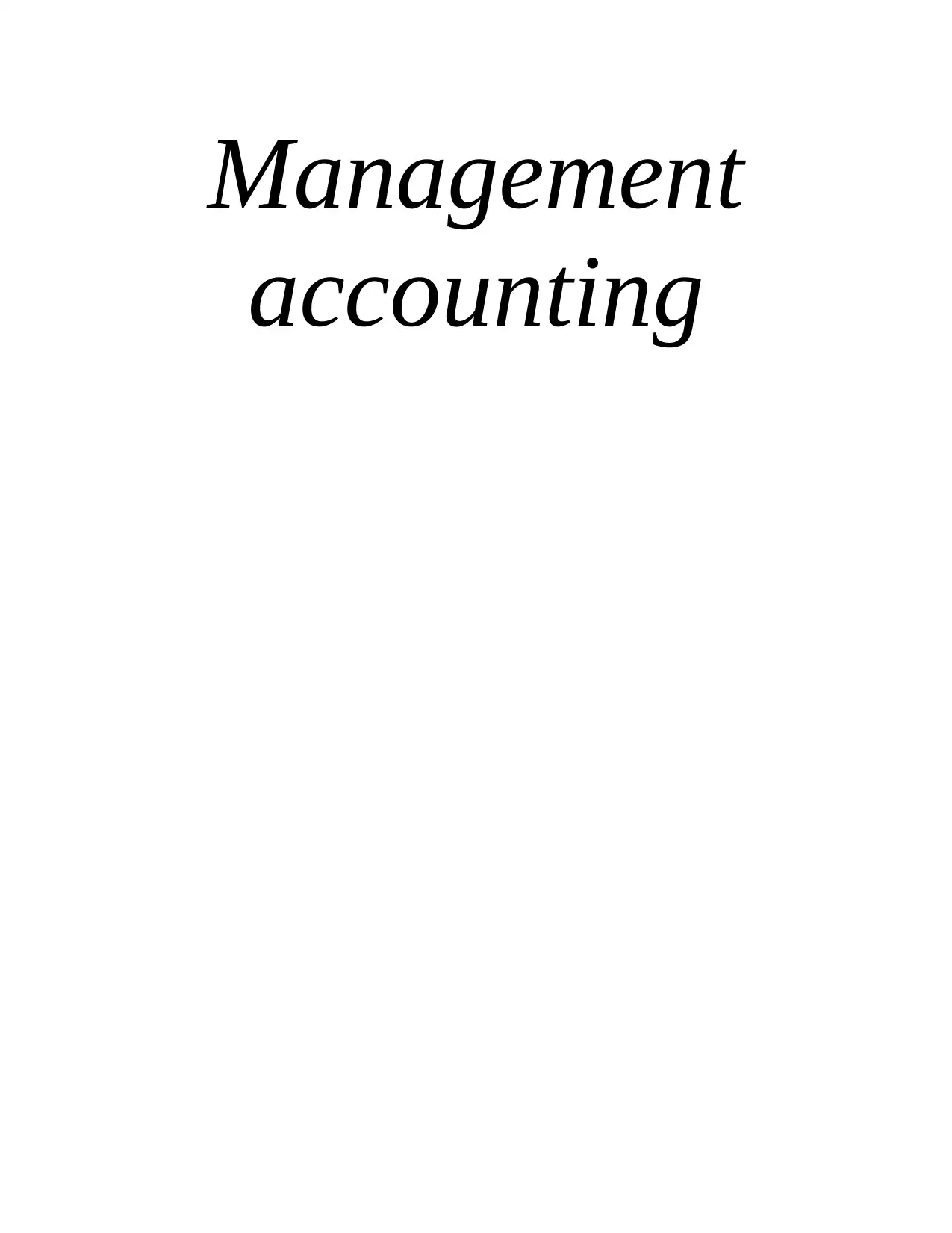
Management
accounting
accounting
Paraphrase This Document
Need a fresh take? Get an instant paraphrase of this document with our AI Paraphraser

TABLE OF CONTENTS
Introduction......................................................................................................................................4
Task 1...............................................................................................................................................4
1.1 Different types of classification of cost.................................................................................4
1.2 Computation of total cost and unit cost of job 444 by making use of job costing................5
1.3 Computation of cost of exquisite by making use of absorption costing technique...............5
1.4 Analysis of cost data of exquisite using appropriate techniques...........................................7
Task 2...............................................................................................................................................8
2.1 Preparation and analysis of routine cost reports....................................................................8
2.2 Use of performance indicators in order to identify potential improvements in business....10
2.3 Recommendation for cost reduction and value enhancement for business.........................10
Task 3.............................................................................................................................................11
3.1 Explanation of purpose and nature of the budgeting process..............................................11
3.2 Selection of appropriate budgeting methods in accordance with the needs of organization
...................................................................................................................................................12
3.3 Preparation of production and material purchase budget....................................................12
3.4 Preparation of cash budget...................................................................................................13
Task 4.............................................................................................................................................16
4.1 Computation of variances along with the identification of possible causes and
recommendation for corrective actions......................................................................................16
4.2 Preparation of reconciliation operating statement...............................................................17
4.3 Management report in accordance with the identified responsibility centres.....................17
Conclusion.....................................................................................................................................18
References......................................................................................................................................19
2
Introduction......................................................................................................................................4
Task 1...............................................................................................................................................4
1.1 Different types of classification of cost.................................................................................4
1.2 Computation of total cost and unit cost of job 444 by making use of job costing................5
1.3 Computation of cost of exquisite by making use of absorption costing technique...............5
1.4 Analysis of cost data of exquisite using appropriate techniques...........................................7
Task 2...............................................................................................................................................8
2.1 Preparation and analysis of routine cost reports....................................................................8
2.2 Use of performance indicators in order to identify potential improvements in business....10
2.3 Recommendation for cost reduction and value enhancement for business.........................10
Task 3.............................................................................................................................................11
3.1 Explanation of purpose and nature of the budgeting process..............................................11
3.2 Selection of appropriate budgeting methods in accordance with the needs of organization
...................................................................................................................................................12
3.3 Preparation of production and material purchase budget....................................................12
3.4 Preparation of cash budget...................................................................................................13
Task 4.............................................................................................................................................16
4.1 Computation of variances along with the identification of possible causes and
recommendation for corrective actions......................................................................................16
4.2 Preparation of reconciliation operating statement...............................................................17
4.3 Management report in accordance with the identified responsibility centres.....................17
Conclusion.....................................................................................................................................18
References......................................................................................................................................19
2

INDEX OF TABLES
Table 1: Computation of cost of Job 444.........................................................................................5
Table 2: Computation of total cost of exquisite...............................................................................5
Table 3: Allocation of cost of support departments on the basis of machine hours........................6
Table 4: Allocation Criteria of cost.................................................................................................6
Table 5: Units to be produced.........................................................................................................6
Table 6: Statement showing computation of exquisite....................................................................7
Table 7: Statement showing computation of exquisite....................................................................7
Table 8: Routine cost report of September......................................................................................8
Table 9: Computation of standard budget at 1900 units..................................................................8
Table 10: Production budget of Jeffrey and Son's smake..............................................................13
Table 11: Material purchase budget of Jeffrey and Son's smake...................................................13
Table 12: Cash budget of Jeffrey and Son's...................................................................................13
Table 17: Computation of variances of Jeffrey and Son's smake..................................................16
Table 18: Reconciliation operating statement of Jeffrey and Son's smake...................................17
3
Table 1: Computation of cost of Job 444.........................................................................................5
Table 2: Computation of total cost of exquisite...............................................................................5
Table 3: Allocation of cost of support departments on the basis of machine hours........................6
Table 4: Allocation Criteria of cost.................................................................................................6
Table 5: Units to be produced.........................................................................................................6
Table 6: Statement showing computation of exquisite....................................................................7
Table 7: Statement showing computation of exquisite....................................................................7
Table 8: Routine cost report of September......................................................................................8
Table 9: Computation of standard budget at 1900 units..................................................................8
Table 10: Production budget of Jeffrey and Son's smake..............................................................13
Table 11: Material purchase budget of Jeffrey and Son's smake...................................................13
Table 12: Cash budget of Jeffrey and Son's...................................................................................13
Table 17: Computation of variances of Jeffrey and Son's smake..................................................16
Table 18: Reconciliation operating statement of Jeffrey and Son's smake...................................17
3
⊘ This is a preview!⊘
Do you want full access?
Subscribe today to unlock all pages.

Trusted by 1+ million students worldwide
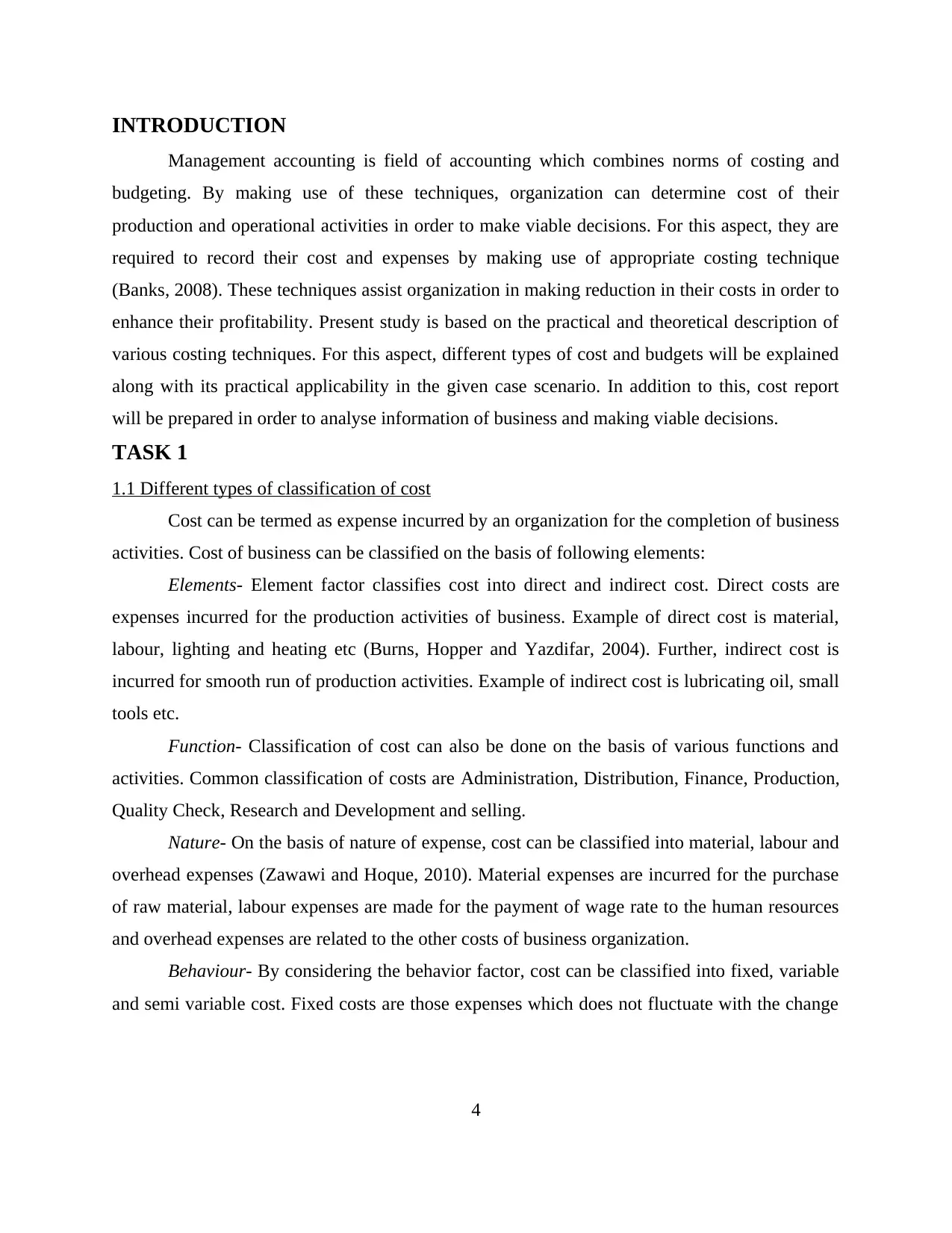
INTRODUCTION
Management accounting is field of accounting which combines norms of costing and
budgeting. By making use of these techniques, organization can determine cost of their
production and operational activities in order to make viable decisions. For this aspect, they are
required to record their cost and expenses by making use of appropriate costing technique
(Banks, 2008). These techniques assist organization in making reduction in their costs in order to
enhance their profitability. Present study is based on the practical and theoretical description of
various costing techniques. For this aspect, different types of cost and budgets will be explained
along with its practical applicability in the given case scenario. In addition to this, cost report
will be prepared in order to analyse information of business and making viable decisions.
TASK 1
1.1 Different types of classification of cost
Cost can be termed as expense incurred by an organization for the completion of business
activities. Cost of business can be classified on the basis of following elements:
Elements- Element factor classifies cost into direct and indirect cost. Direct costs are
expenses incurred for the production activities of business. Example of direct cost is material,
labour, lighting and heating etc (Burns, Hopper and Yazdifar, 2004). Further, indirect cost is
incurred for smooth run of production activities. Example of indirect cost is lubricating oil, small
tools etc.
Function- Classification of cost can also be done on the basis of various functions and
activities. Common classification of costs are Administration, Distribution, Finance, Production,
Quality Check, Research and Development and selling.
Nature- On the basis of nature of expense, cost can be classified into material, labour and
overhead expenses (Zawawi and Hoque, 2010). Material expenses are incurred for the purchase
of raw material, labour expenses are made for the payment of wage rate to the human resources
and overhead expenses are related to the other costs of business organization.
Behaviour- By considering the behavior factor, cost can be classified into fixed, variable
and semi variable cost. Fixed costs are those expenses which does not fluctuate with the change
4
Management accounting is field of accounting which combines norms of costing and
budgeting. By making use of these techniques, organization can determine cost of their
production and operational activities in order to make viable decisions. For this aspect, they are
required to record their cost and expenses by making use of appropriate costing technique
(Banks, 2008). These techniques assist organization in making reduction in their costs in order to
enhance their profitability. Present study is based on the practical and theoretical description of
various costing techniques. For this aspect, different types of cost and budgets will be explained
along with its practical applicability in the given case scenario. In addition to this, cost report
will be prepared in order to analyse information of business and making viable decisions.
TASK 1
1.1 Different types of classification of cost
Cost can be termed as expense incurred by an organization for the completion of business
activities. Cost of business can be classified on the basis of following elements:
Elements- Element factor classifies cost into direct and indirect cost. Direct costs are
expenses incurred for the production activities of business. Example of direct cost is material,
labour, lighting and heating etc (Burns, Hopper and Yazdifar, 2004). Further, indirect cost is
incurred for smooth run of production activities. Example of indirect cost is lubricating oil, small
tools etc.
Function- Classification of cost can also be done on the basis of various functions and
activities. Common classification of costs are Administration, Distribution, Finance, Production,
Quality Check, Research and Development and selling.
Nature- On the basis of nature of expense, cost can be classified into material, labour and
overhead expenses (Zawawi and Hoque, 2010). Material expenses are incurred for the purchase
of raw material, labour expenses are made for the payment of wage rate to the human resources
and overhead expenses are related to the other costs of business organization.
Behaviour- By considering the behavior factor, cost can be classified into fixed, variable
and semi variable cost. Fixed costs are those expenses which does not fluctuate with the change
4
Paraphrase This Document
Need a fresh take? Get an instant paraphrase of this document with our AI Paraphraser
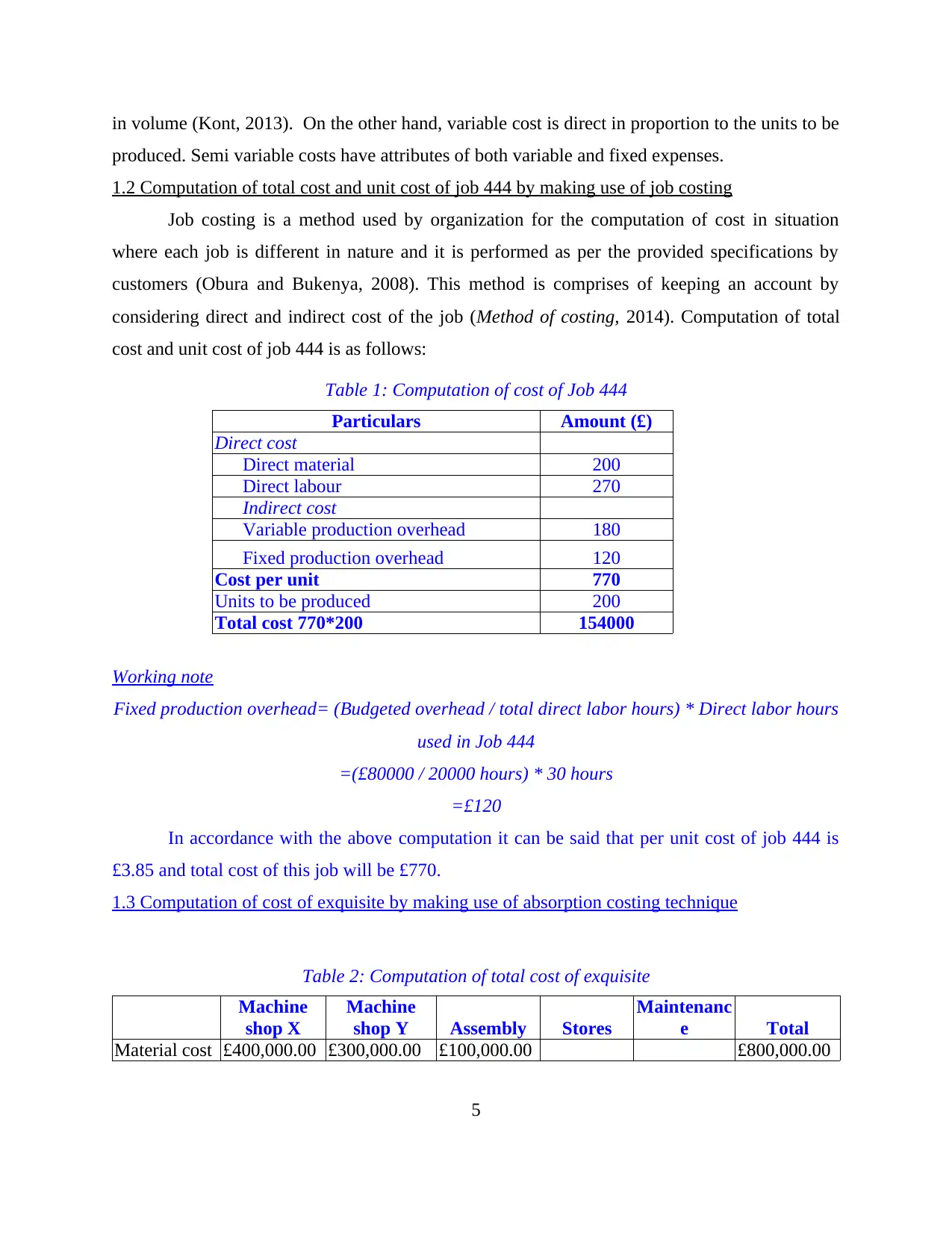
in volume (Kont, 2013). On the other hand, variable cost is direct in proportion to the units to be
produced. Semi variable costs have attributes of both variable and fixed expenses.
1.2 Computation of total cost and unit cost of job 444 by making use of job costing
Job costing is a method used by organization for the computation of cost in situation
where each job is different in nature and it is performed as per the provided specifications by
customers (Obura and Bukenya, 2008). This method is comprises of keeping an account by
considering direct and indirect cost of the job (Method of costing, 2014). Computation of total
cost and unit cost of job 444 is as follows:
Table 1: Computation of cost of Job 444
Particulars Amount (£)
Direct cost
Direct material 200
Direct labour 270
Indirect cost
Variable production overhead 180
Fixed production overhead 120
Cost per unit 770
Units to be produced 200
Total cost 770*200 154000
Working note
Fixed production overhead= (Budgeted overhead / total direct labor hours) * Direct labor hours
used in Job 444
=(£80000 / 20000 hours) * 30 hours
=£120
In accordance with the above computation it can be said that per unit cost of job 444 is
£3.85 and total cost of this job will be £770.
1.3 Computation of cost of exquisite by making use of absorption costing technique
Table 2: Computation of total cost of exquisite
Machine
shop X
Machine
shop Y Assembly Stores
Maintenanc
e Total
Material cost £400,000.00 £300,000.00 £100,000.00 £800,000.00
5
produced. Semi variable costs have attributes of both variable and fixed expenses.
1.2 Computation of total cost and unit cost of job 444 by making use of job costing
Job costing is a method used by organization for the computation of cost in situation
where each job is different in nature and it is performed as per the provided specifications by
customers (Obura and Bukenya, 2008). This method is comprises of keeping an account by
considering direct and indirect cost of the job (Method of costing, 2014). Computation of total
cost and unit cost of job 444 is as follows:
Table 1: Computation of cost of Job 444
Particulars Amount (£)
Direct cost
Direct material 200
Direct labour 270
Indirect cost
Variable production overhead 180
Fixed production overhead 120
Cost per unit 770
Units to be produced 200
Total cost 770*200 154000
Working note
Fixed production overhead= (Budgeted overhead / total direct labor hours) * Direct labor hours
used in Job 444
=(£80000 / 20000 hours) * 30 hours
=£120
In accordance with the above computation it can be said that per unit cost of job 444 is
£3.85 and total cost of this job will be £770.
1.3 Computation of cost of exquisite by making use of absorption costing technique
Table 2: Computation of total cost of exquisite
Machine
shop X
Machine
shop Y Assembly Stores
Maintenanc
e Total
Material cost £400,000.00 £300,000.00 £100,000.00 £800,000.00
5
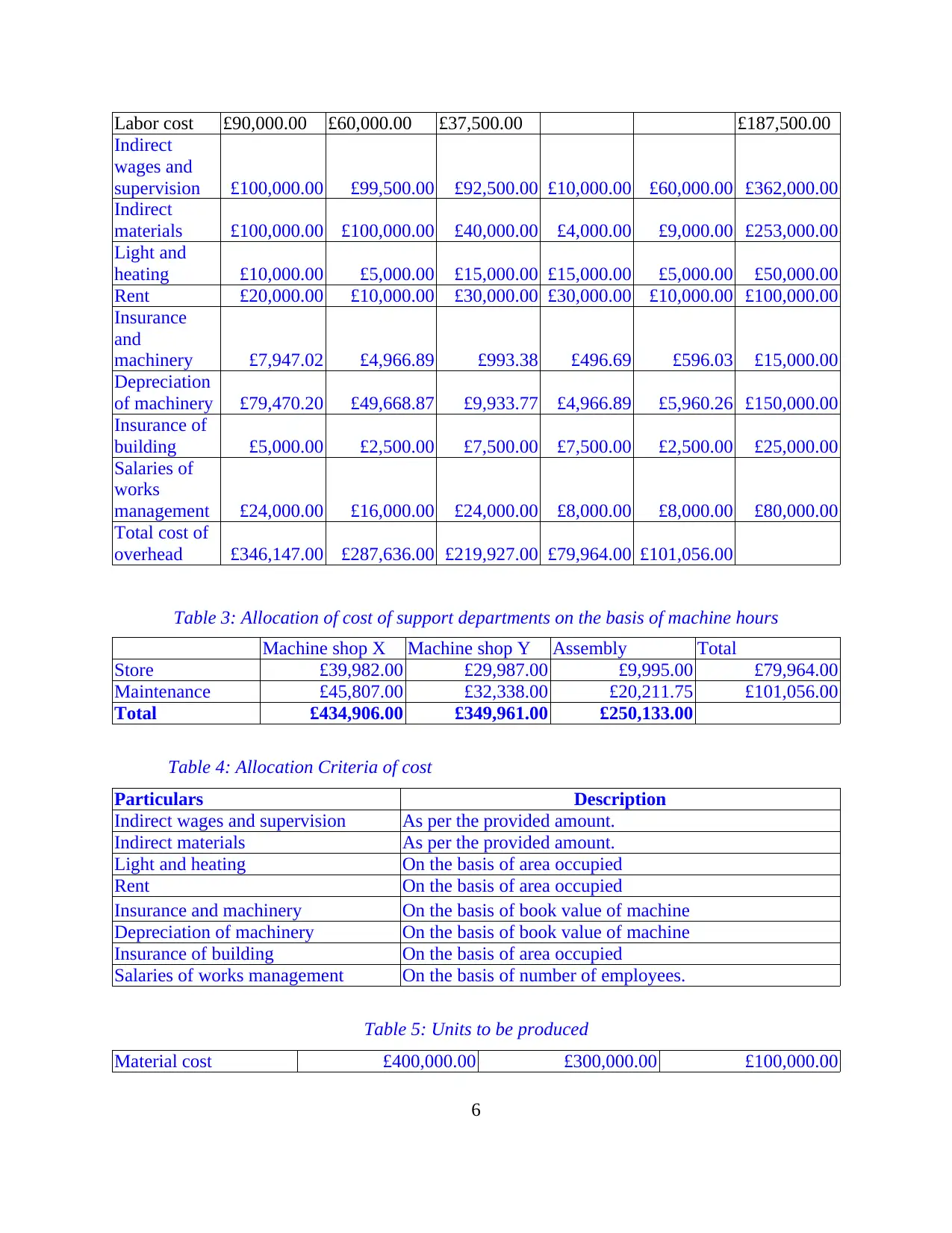
Labor cost £90,000.00 £60,000.00 £37,500.00 £187,500.00
Indirect
wages and
supervision £100,000.00 £99,500.00 £92,500.00 £10,000.00 £60,000.00 £362,000.00
Indirect
materials £100,000.00 £100,000.00 £40,000.00 £4,000.00 £9,000.00 £253,000.00
Light and
heating £10,000.00 £5,000.00 £15,000.00 £15,000.00 £5,000.00 £50,000.00
Rent £20,000.00 £10,000.00 £30,000.00 £30,000.00 £10,000.00 £100,000.00
Insurance
and
machinery £7,947.02 £4,966.89 £993.38 £496.69 £596.03 £15,000.00
Depreciation
of machinery £79,470.20 £49,668.87 £9,933.77 £4,966.89 £5,960.26 £150,000.00
Insurance of
building £5,000.00 £2,500.00 £7,500.00 £7,500.00 £2,500.00 £25,000.00
Salaries of
works
management £24,000.00 £16,000.00 £24,000.00 £8,000.00 £8,000.00 £80,000.00
Total cost of
overhead £346,147.00 £287,636.00 £219,927.00 £79,964.00 £101,056.00
Table 3: Allocation of cost of support departments on the basis of machine hours
Machine shop X Machine shop Y Assembly Total
Store £39,982.00 £29,987.00 £9,995.00 £79,964.00
Maintenance £45,807.00 £32,338.00 £20,211.75 £101,056.00
Total £434,906.00 £349,961.00 £250,133.00
Table 4: Allocation Criteria of cost
Particulars Description
Indirect wages and supervision As per the provided amount.
Indirect materials As per the provided amount.
Light and heating On the basis of area occupied
Rent On the basis of area occupied
Insurance and machinery On the basis of book value of machine
Depreciation of machinery On the basis of book value of machine
Insurance of building On the basis of area occupied
Salaries of works management On the basis of number of employees.
Table 5: Units to be produced
Material cost £400,000.00 £300,000.00 £100,000.00
6
Indirect
wages and
supervision £100,000.00 £99,500.00 £92,500.00 £10,000.00 £60,000.00 £362,000.00
Indirect
materials £100,000.00 £100,000.00 £40,000.00 £4,000.00 £9,000.00 £253,000.00
Light and
heating £10,000.00 £5,000.00 £15,000.00 £15,000.00 £5,000.00 £50,000.00
Rent £20,000.00 £10,000.00 £30,000.00 £30,000.00 £10,000.00 £100,000.00
Insurance
and
machinery £7,947.02 £4,966.89 £993.38 £496.69 £596.03 £15,000.00
Depreciation
of machinery £79,470.20 £49,668.87 £9,933.77 £4,966.89 £5,960.26 £150,000.00
Insurance of
building £5,000.00 £2,500.00 £7,500.00 £7,500.00 £2,500.00 £25,000.00
Salaries of
works
management £24,000.00 £16,000.00 £24,000.00 £8,000.00 £8,000.00 £80,000.00
Total cost of
overhead £346,147.00 £287,636.00 £219,927.00 £79,964.00 £101,056.00
Table 3: Allocation of cost of support departments on the basis of machine hours
Machine shop X Machine shop Y Assembly Total
Store £39,982.00 £29,987.00 £9,995.00 £79,964.00
Maintenance £45,807.00 £32,338.00 £20,211.75 £101,056.00
Total £434,906.00 £349,961.00 £250,133.00
Table 4: Allocation Criteria of cost
Particulars Description
Indirect wages and supervision As per the provided amount.
Indirect materials As per the provided amount.
Light and heating On the basis of area occupied
Rent On the basis of area occupied
Insurance and machinery On the basis of book value of machine
Depreciation of machinery On the basis of book value of machine
Insurance of building On the basis of area occupied
Salaries of works management On the basis of number of employees.
Table 5: Units to be produced
Material cost £400,000.00 £300,000.00 £100,000.00
6
⊘ This is a preview!⊘
Do you want full access?
Subscribe today to unlock all pages.

Trusted by 1+ million students worldwide
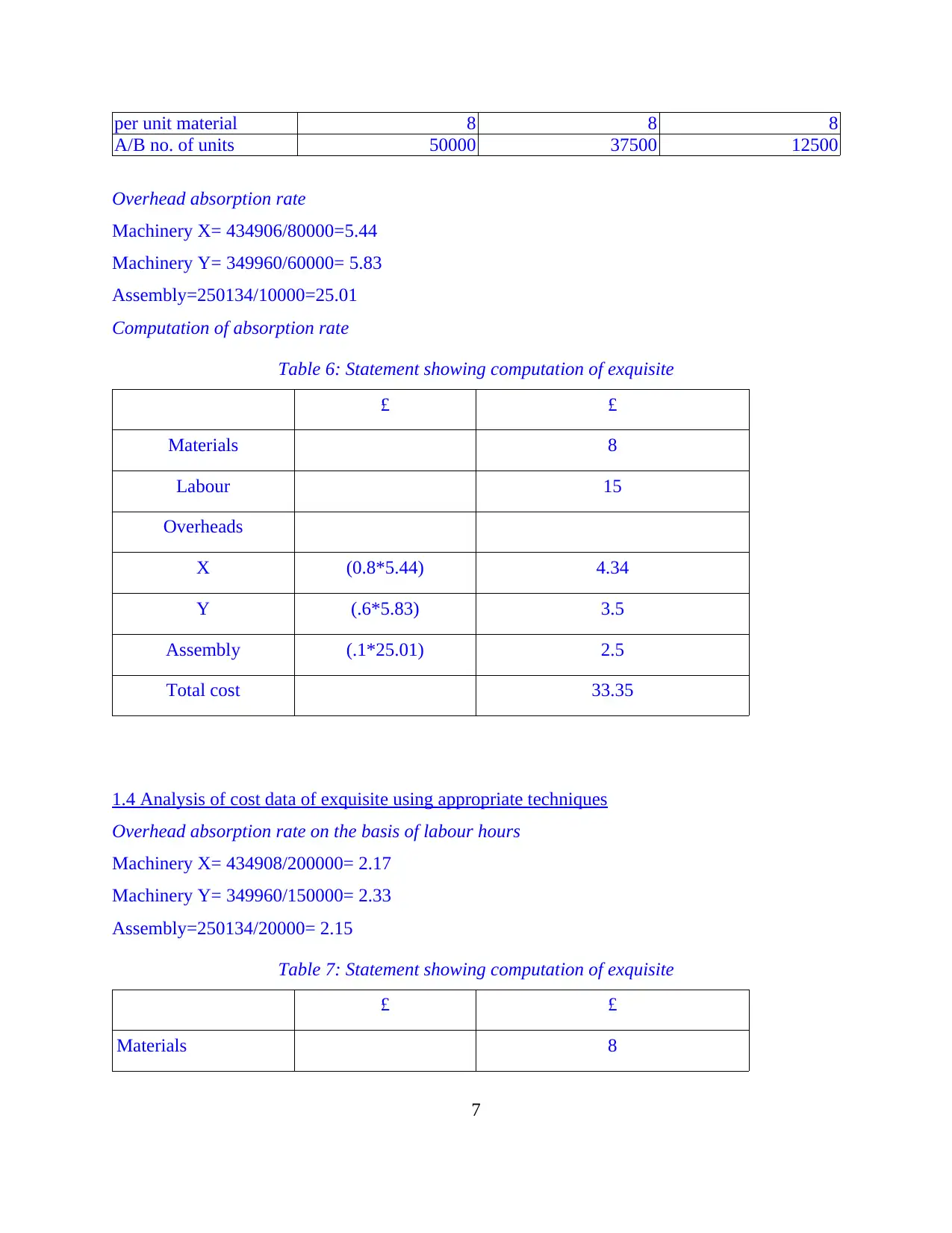
per unit material 8 8 8
A/B no. of units 50000 37500 12500
Overhead absorption rate
Machinery X= 434906/80000=5.44
Machinery Y= 349960/60000= 5.83
Assembly=250134/10000=25.01
Computation of absorption rate
Table 6: Statement showing computation of exquisite
£ £
Materials 8
Labour 15
Overheads
X (0.8*5.44) 4.34
Y (.6*5.83) 3.5
Assembly (.1*25.01) 2.5
Total cost 33.35
1.4 Analysis of cost data of exquisite using appropriate techniques
Overhead absorption rate on the basis of labour hours
Machinery X= 434908/200000= 2.17
Machinery Y= 349960/150000= 2.33
Assembly=250134/20000= 2.15
Table 7: Statement showing computation of exquisite
£ £
Materials 8
7
A/B no. of units 50000 37500 12500
Overhead absorption rate
Machinery X= 434906/80000=5.44
Machinery Y= 349960/60000= 5.83
Assembly=250134/10000=25.01
Computation of absorption rate
Table 6: Statement showing computation of exquisite
£ £
Materials 8
Labour 15
Overheads
X (0.8*5.44) 4.34
Y (.6*5.83) 3.5
Assembly (.1*25.01) 2.5
Total cost 33.35
1.4 Analysis of cost data of exquisite using appropriate techniques
Overhead absorption rate on the basis of labour hours
Machinery X= 434908/200000= 2.17
Machinery Y= 349960/150000= 2.33
Assembly=250134/20000= 2.15
Table 7: Statement showing computation of exquisite
£ £
Materials 8
7
Paraphrase This Document
Need a fresh take? Get an instant paraphrase of this document with our AI Paraphraser
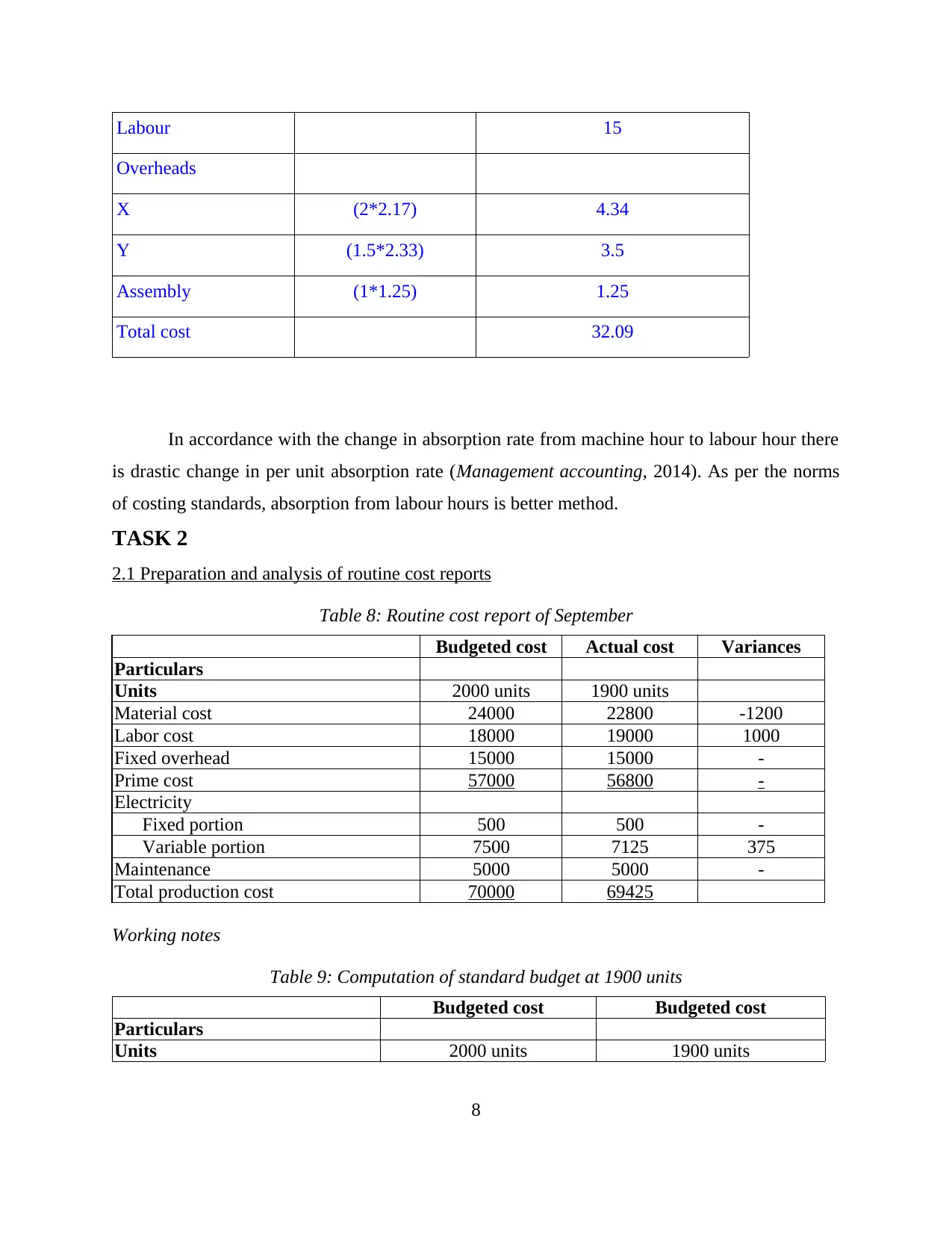
Labour 15
Overheads
X (2*2.17) 4.34
Y (1.5*2.33) 3.5
Assembly (1*1.25) 1.25
Total cost 32.09
In accordance with the change in absorption rate from machine hour to labour hour there
is drastic change in per unit absorption rate (Management accounting, 2014). As per the norms
of costing standards, absorption from labour hours is better method.
TASK 2
2.1 Preparation and analysis of routine cost reports
Table 8: Routine cost report of September
Budgeted cost Actual cost Variances
Particulars
Units 2000 units 1900 units
Material cost 24000 22800 -1200
Labor cost 18000 19000 1000
Fixed overhead 15000 15000 -
Prime cost 57000 56800 -
Electricity
Fixed portion 500 500 -
Variable portion 7500 7125 375
Maintenance 5000 5000 -
Total production cost 70000 69425
Working notes
Table 9: Computation of standard budget at 1900 units
Budgeted cost Budgeted cost
Particulars
Units 2000 units 1900 units
8
Overheads
X (2*2.17) 4.34
Y (1.5*2.33) 3.5
Assembly (1*1.25) 1.25
Total cost 32.09
In accordance with the change in absorption rate from machine hour to labour hour there
is drastic change in per unit absorption rate (Management accounting, 2014). As per the norms
of costing standards, absorption from labour hours is better method.
TASK 2
2.1 Preparation and analysis of routine cost reports
Table 8: Routine cost report of September
Budgeted cost Actual cost Variances
Particulars
Units 2000 units 1900 units
Material cost 24000 22800 -1200
Labor cost 18000 19000 1000
Fixed overhead 15000 15000 -
Prime cost 57000 56800 -
Electricity
Fixed portion 500 500 -
Variable portion 7500 7125 375
Maintenance 5000 5000 -
Total production cost 70000 69425
Working notes
Table 9: Computation of standard budget at 1900 units
Budgeted cost Budgeted cost
Particulars
Units 2000 units 1900 units
8
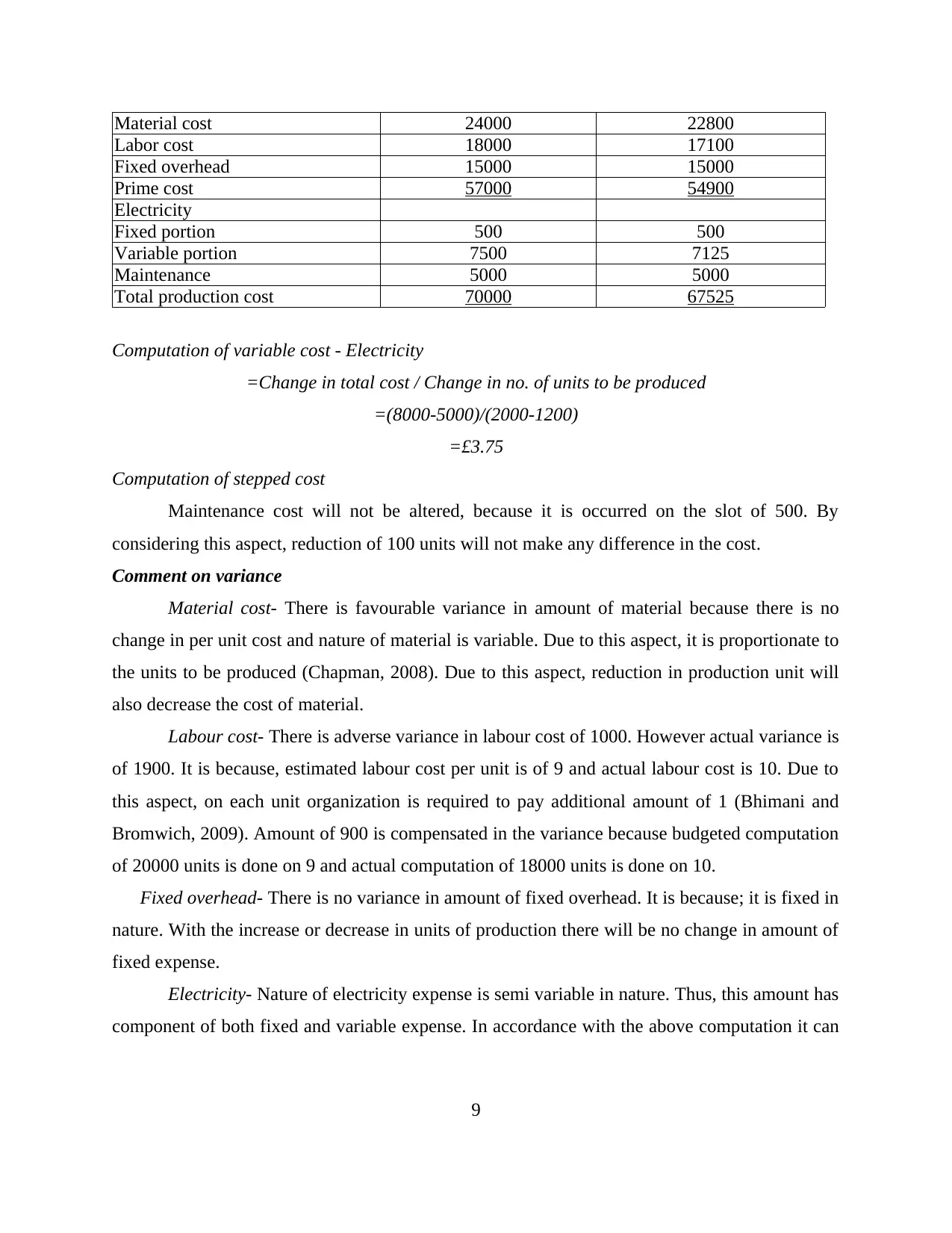
Material cost 24000 22800
Labor cost 18000 17100
Fixed overhead 15000 15000
Prime cost 57000 54900
Electricity
Fixed portion 500 500
Variable portion 7500 7125
Maintenance 5000 5000
Total production cost 70000 67525
Computation of variable cost - Electricity
=Change in total cost / Change in no. of units to be produced
=(8000-5000)/(2000-1200)
=£3.75
Computation of stepped cost
Maintenance cost will not be altered, because it is occurred on the slot of 500. By
considering this aspect, reduction of 100 units will not make any difference in the cost.
Comment on variance
Material cost- There is favourable variance in amount of material because there is no
change in per unit cost and nature of material is variable. Due to this aspect, it is proportionate to
the units to be produced (Chapman, 2008). Due to this aspect, reduction in production unit will
also decrease the cost of material.
Labour cost- There is adverse variance in labour cost of 1000. However actual variance is
of 1900. It is because, estimated labour cost per unit is of 9 and actual labour cost is 10. Due to
this aspect, on each unit organization is required to pay additional amount of 1 (Bhimani and
Bromwich, 2009). Amount of 900 is compensated in the variance because budgeted computation
of 20000 units is done on 9 and actual computation of 18000 units is done on 10.
Fixed overhead- There is no variance in amount of fixed overhead. It is because; it is fixed in
nature. With the increase or decrease in units of production there will be no change in amount of
fixed expense.
Electricity- Nature of electricity expense is semi variable in nature. Thus, this amount has
component of both fixed and variable expense. In accordance with the above computation it can
9
Labor cost 18000 17100
Fixed overhead 15000 15000
Prime cost 57000 54900
Electricity
Fixed portion 500 500
Variable portion 7500 7125
Maintenance 5000 5000
Total production cost 70000 67525
Computation of variable cost - Electricity
=Change in total cost / Change in no. of units to be produced
=(8000-5000)/(2000-1200)
=£3.75
Computation of stepped cost
Maintenance cost will not be altered, because it is occurred on the slot of 500. By
considering this aspect, reduction of 100 units will not make any difference in the cost.
Comment on variance
Material cost- There is favourable variance in amount of material because there is no
change in per unit cost and nature of material is variable. Due to this aspect, it is proportionate to
the units to be produced (Chapman, 2008). Due to this aspect, reduction in production unit will
also decrease the cost of material.
Labour cost- There is adverse variance in labour cost of 1000. However actual variance is
of 1900. It is because, estimated labour cost per unit is of 9 and actual labour cost is 10. Due to
this aspect, on each unit organization is required to pay additional amount of 1 (Bhimani and
Bromwich, 2009). Amount of 900 is compensated in the variance because budgeted computation
of 20000 units is done on 9 and actual computation of 18000 units is done on 10.
Fixed overhead- There is no variance in amount of fixed overhead. It is because; it is fixed in
nature. With the increase or decrease in units of production there will be no change in amount of
fixed expense.
Electricity- Nature of electricity expense is semi variable in nature. Thus, this amount has
component of both fixed and variable expense. In accordance with the above computation it can
9
⊘ This is a preview!⊘
Do you want full access?
Subscribe today to unlock all pages.

Trusted by 1+ million students worldwide
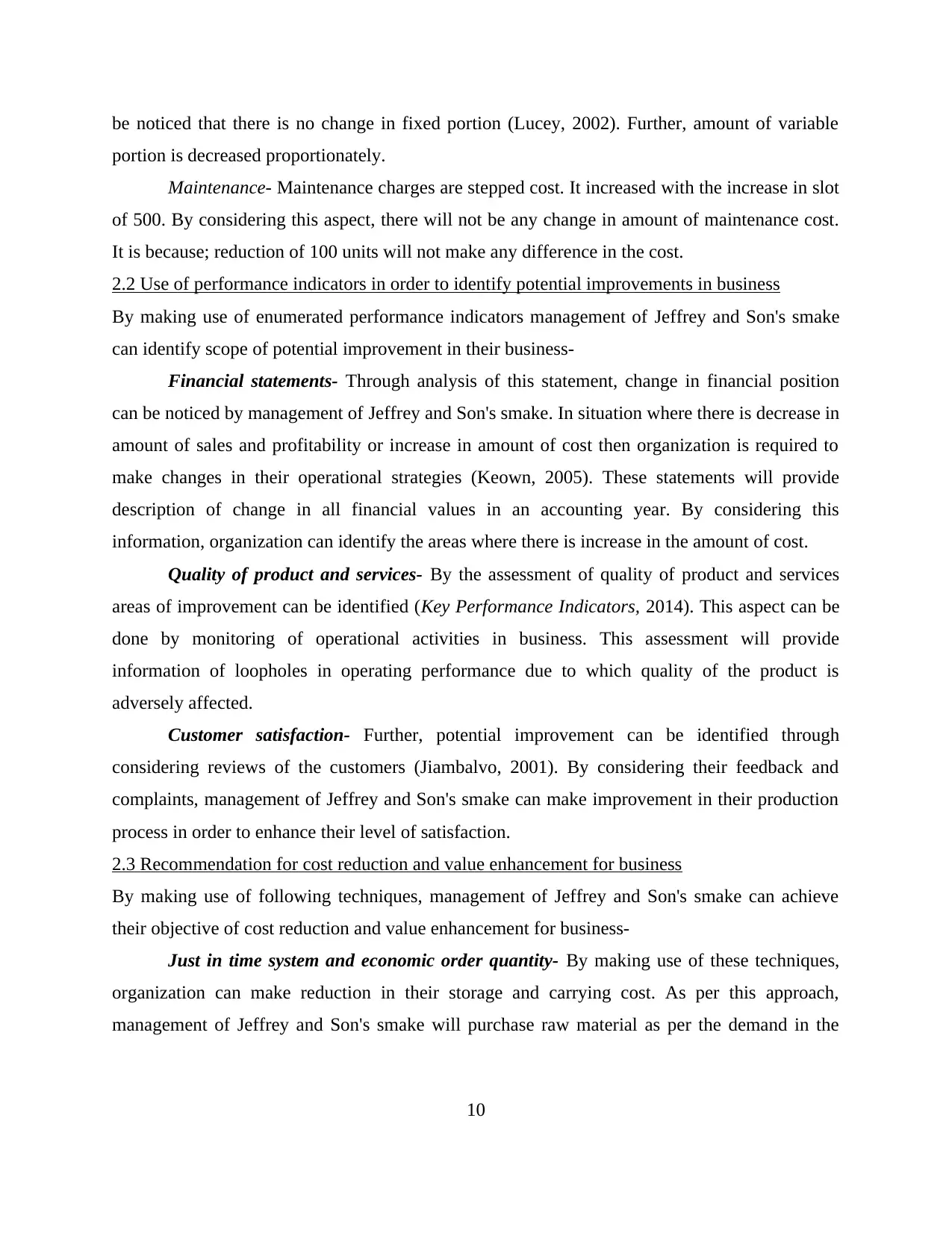
be noticed that there is no change in fixed portion (Lucey, 2002). Further, amount of variable
portion is decreased proportionately.
Maintenance- Maintenance charges are stepped cost. It increased with the increase in slot
of 500. By considering this aspect, there will not be any change in amount of maintenance cost.
It is because; reduction of 100 units will not make any difference in the cost.
2.2 Use of performance indicators in order to identify potential improvements in business
By making use of enumerated performance indicators management of Jeffrey and Son's smake
can identify scope of potential improvement in their business-
Financial statements- Through analysis of this statement, change in financial position
can be noticed by management of Jeffrey and Son's smake. In situation where there is decrease in
amount of sales and profitability or increase in amount of cost then organization is required to
make changes in their operational strategies (Keown, 2005). These statements will provide
description of change in all financial values in an accounting year. By considering this
information, organization can identify the areas where there is increase in the amount of cost.
Quality of product and services- By the assessment of quality of product and services
areas of improvement can be identified (Key Performance Indicators, 2014). This aspect can be
done by monitoring of operational activities in business. This assessment will provide
information of loopholes in operating performance due to which quality of the product is
adversely affected.
Customer satisfaction- Further, potential improvement can be identified through
considering reviews of the customers (Jiambalvo, 2001). By considering their feedback and
complaints, management of Jeffrey and Son's smake can make improvement in their production
process in order to enhance their level of satisfaction.
2.3 Recommendation for cost reduction and value enhancement for business
By making use of following techniques, management of Jeffrey and Son's smake can achieve
their objective of cost reduction and value enhancement for business-
Just in time system and economic order quantity- By making use of these techniques,
organization can make reduction in their storage and carrying cost. As per this approach,
management of Jeffrey and Son's smake will purchase raw material as per the demand in the
10
portion is decreased proportionately.
Maintenance- Maintenance charges are stepped cost. It increased with the increase in slot
of 500. By considering this aspect, there will not be any change in amount of maintenance cost.
It is because; reduction of 100 units will not make any difference in the cost.
2.2 Use of performance indicators in order to identify potential improvements in business
By making use of enumerated performance indicators management of Jeffrey and Son's smake
can identify scope of potential improvement in their business-
Financial statements- Through analysis of this statement, change in financial position
can be noticed by management of Jeffrey and Son's smake. In situation where there is decrease in
amount of sales and profitability or increase in amount of cost then organization is required to
make changes in their operational strategies (Keown, 2005). These statements will provide
description of change in all financial values in an accounting year. By considering this
information, organization can identify the areas where there is increase in the amount of cost.
Quality of product and services- By the assessment of quality of product and services
areas of improvement can be identified (Key Performance Indicators, 2014). This aspect can be
done by monitoring of operational activities in business. This assessment will provide
information of loopholes in operating performance due to which quality of the product is
adversely affected.
Customer satisfaction- Further, potential improvement can be identified through
considering reviews of the customers (Jiambalvo, 2001). By considering their feedback and
complaints, management of Jeffrey and Son's smake can make improvement in their production
process in order to enhance their level of satisfaction.
2.3 Recommendation for cost reduction and value enhancement for business
By making use of following techniques, management of Jeffrey and Son's smake can achieve
their objective of cost reduction and value enhancement for business-
Just in time system and economic order quantity- By making use of these techniques,
organization can make reduction in their storage and carrying cost. As per this approach,
management of Jeffrey and Son's smake will purchase raw material as per the demand in the
10
Paraphrase This Document
Need a fresh take? Get an instant paraphrase of this document with our AI Paraphraser
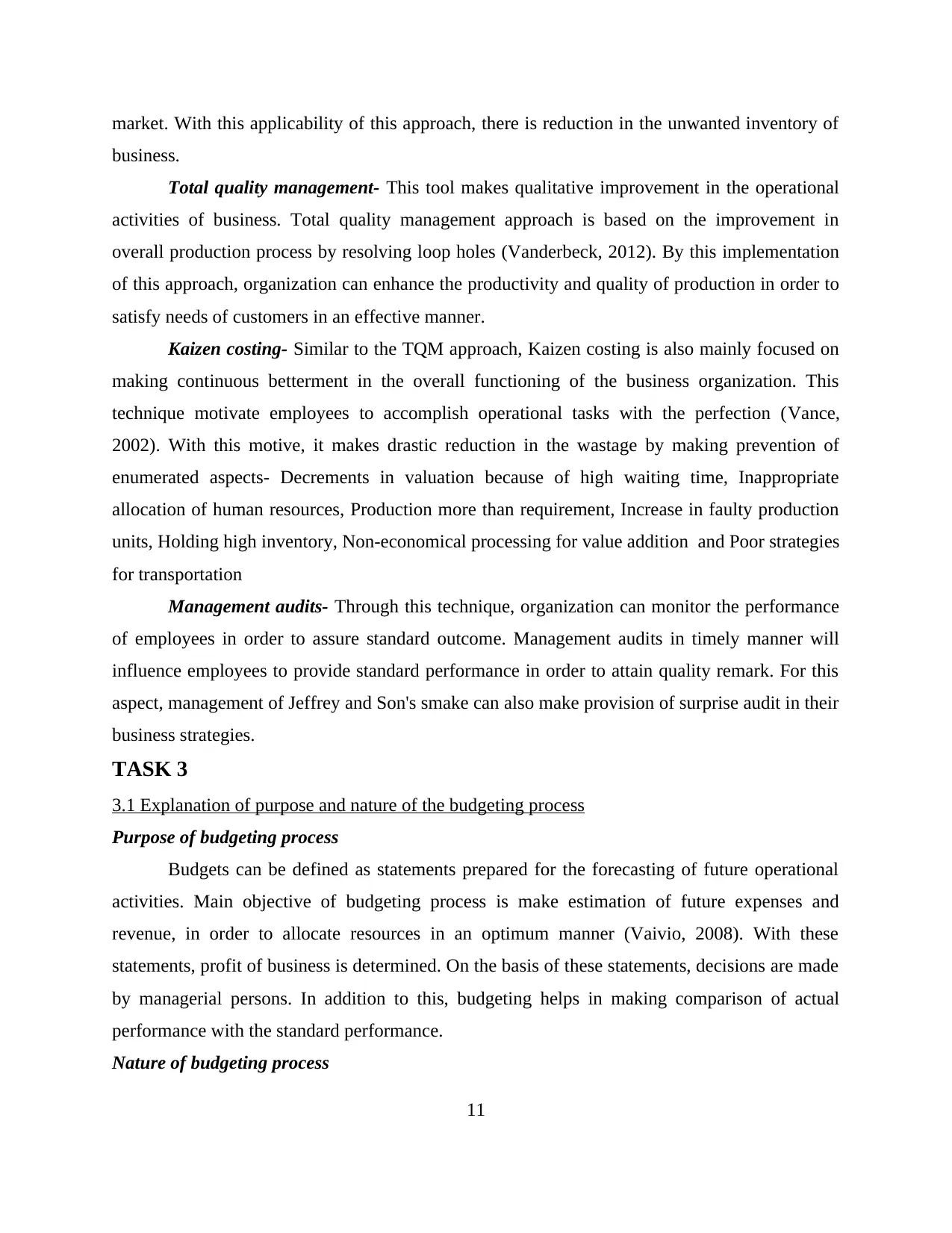
market. With this applicability of this approach, there is reduction in the unwanted inventory of
business.
Total quality management- This tool makes qualitative improvement in the operational
activities of business. Total quality management approach is based on the improvement in
overall production process by resolving loop holes (Vanderbeck, 2012). By this implementation
of this approach, organization can enhance the productivity and quality of production in order to
satisfy needs of customers in an effective manner.
Kaizen costing- Similar to the TQM approach, Kaizen costing is also mainly focused on
making continuous betterment in the overall functioning of the business organization. This
technique motivate employees to accomplish operational tasks with the perfection (Vance,
2002). With this motive, it makes drastic reduction in the wastage by making prevention of
enumerated aspects- Decrements in valuation because of high waiting time, Inappropriate
allocation of human resources, Production more than requirement, Increase in faulty production
units, Holding high inventory, Non-economical processing for value addition and Poor strategies
for transportation
Management audits- Through this technique, organization can monitor the performance
of employees in order to assure standard outcome. Management audits in timely manner will
influence employees to provide standard performance in order to attain quality remark. For this
aspect, management of Jeffrey and Son's smake can also make provision of surprise audit in their
business strategies.
TASK 3
3.1 Explanation of purpose and nature of the budgeting process
Purpose of budgeting process
Budgets can be defined as statements prepared for the forecasting of future operational
activities. Main objective of budgeting process is make estimation of future expenses and
revenue, in order to allocate resources in an optimum manner (Vaivio, 2008). With these
statements, profit of business is determined. On the basis of these statements, decisions are made
by managerial persons. In addition to this, budgeting helps in making comparison of actual
performance with the standard performance.
Nature of budgeting process
11
business.
Total quality management- This tool makes qualitative improvement in the operational
activities of business. Total quality management approach is based on the improvement in
overall production process by resolving loop holes (Vanderbeck, 2012). By this implementation
of this approach, organization can enhance the productivity and quality of production in order to
satisfy needs of customers in an effective manner.
Kaizen costing- Similar to the TQM approach, Kaizen costing is also mainly focused on
making continuous betterment in the overall functioning of the business organization. This
technique motivate employees to accomplish operational tasks with the perfection (Vance,
2002). With this motive, it makes drastic reduction in the wastage by making prevention of
enumerated aspects- Decrements in valuation because of high waiting time, Inappropriate
allocation of human resources, Production more than requirement, Increase in faulty production
units, Holding high inventory, Non-economical processing for value addition and Poor strategies
for transportation
Management audits- Through this technique, organization can monitor the performance
of employees in order to assure standard outcome. Management audits in timely manner will
influence employees to provide standard performance in order to attain quality remark. For this
aspect, management of Jeffrey and Son's smake can also make provision of surprise audit in their
business strategies.
TASK 3
3.1 Explanation of purpose and nature of the budgeting process
Purpose of budgeting process
Budgets can be defined as statements prepared for the forecasting of future operational
activities. Main objective of budgeting process is make estimation of future expenses and
revenue, in order to allocate resources in an optimum manner (Vaivio, 2008). With these
statements, profit of business is determined. On the basis of these statements, decisions are made
by managerial persons. In addition to this, budgeting helps in making comparison of actual
performance with the standard performance.
Nature of budgeting process
11
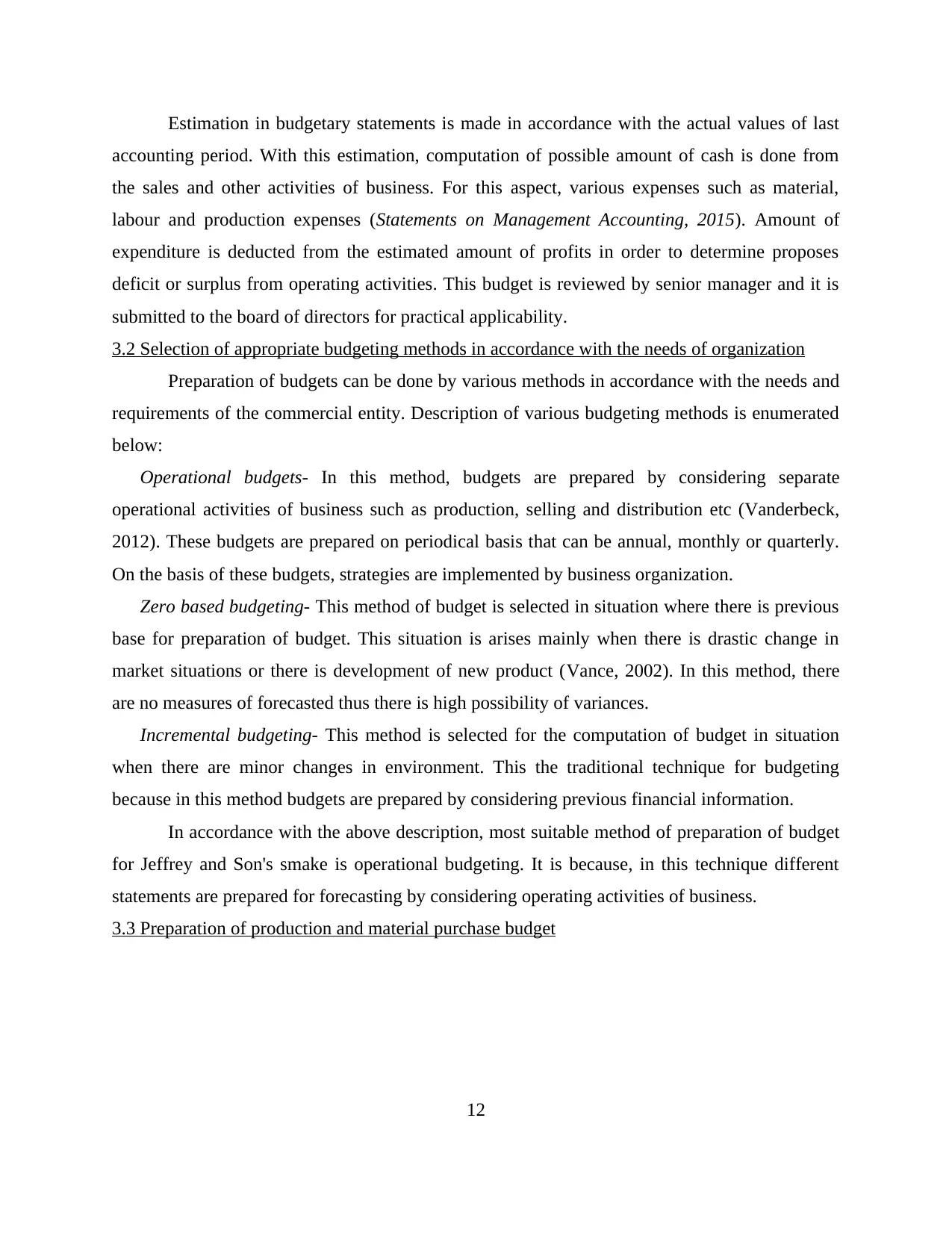
Estimation in budgetary statements is made in accordance with the actual values of last
accounting period. With this estimation, computation of possible amount of cash is done from
the sales and other activities of business. For this aspect, various expenses such as material,
labour and production expenses (Statements on Management Accounting, 2015). Amount of
expenditure is deducted from the estimated amount of profits in order to determine proposes
deficit or surplus from operating activities. This budget is reviewed by senior manager and it is
submitted to the board of directors for practical applicability.
3.2 Selection of appropriate budgeting methods in accordance with the needs of organization
Preparation of budgets can be done by various methods in accordance with the needs and
requirements of the commercial entity. Description of various budgeting methods is enumerated
below:
Operational budgets- In this method, budgets are prepared by considering separate
operational activities of business such as production, selling and distribution etc (Vanderbeck,
2012). These budgets are prepared on periodical basis that can be annual, monthly or quarterly.
On the basis of these budgets, strategies are implemented by business organization.
Zero based budgeting- This method of budget is selected in situation where there is previous
base for preparation of budget. This situation is arises mainly when there is drastic change in
market situations or there is development of new product (Vance, 2002). In this method, there
are no measures of forecasted thus there is high possibility of variances.
Incremental budgeting- This method is selected for the computation of budget in situation
when there are minor changes in environment. This the traditional technique for budgeting
because in this method budgets are prepared by considering previous financial information.
In accordance with the above description, most suitable method of preparation of budget
for Jeffrey and Son's smake is operational budgeting. It is because, in this technique different
statements are prepared for forecasting by considering operating activities of business.
3.3 Preparation of production and material purchase budget
12
accounting period. With this estimation, computation of possible amount of cash is done from
the sales and other activities of business. For this aspect, various expenses such as material,
labour and production expenses (Statements on Management Accounting, 2015). Amount of
expenditure is deducted from the estimated amount of profits in order to determine proposes
deficit or surplus from operating activities. This budget is reviewed by senior manager and it is
submitted to the board of directors for practical applicability.
3.2 Selection of appropriate budgeting methods in accordance with the needs of organization
Preparation of budgets can be done by various methods in accordance with the needs and
requirements of the commercial entity. Description of various budgeting methods is enumerated
below:
Operational budgets- In this method, budgets are prepared by considering separate
operational activities of business such as production, selling and distribution etc (Vanderbeck,
2012). These budgets are prepared on periodical basis that can be annual, monthly or quarterly.
On the basis of these budgets, strategies are implemented by business organization.
Zero based budgeting- This method of budget is selected in situation where there is previous
base for preparation of budget. This situation is arises mainly when there is drastic change in
market situations or there is development of new product (Vance, 2002). In this method, there
are no measures of forecasted thus there is high possibility of variances.
Incremental budgeting- This method is selected for the computation of budget in situation
when there are minor changes in environment. This the traditional technique for budgeting
because in this method budgets are prepared by considering previous financial information.
In accordance with the above description, most suitable method of preparation of budget
for Jeffrey and Son's smake is operational budgeting. It is because, in this technique different
statements are prepared for forecasting by considering operating activities of business.
3.3 Preparation of production and material purchase budget
12
⊘ This is a preview!⊘
Do you want full access?
Subscribe today to unlock all pages.

Trusted by 1+ million students worldwide
1 out of 20
Related Documents
Your All-in-One AI-Powered Toolkit for Academic Success.
+13062052269
info@desklib.com
Available 24*7 on WhatsApp / Email
![[object Object]](/_next/static/media/star-bottom.7253800d.svg)
Unlock your academic potential
Copyright © 2020–2025 A2Z Services. All Rights Reserved. Developed and managed by ZUCOL.





